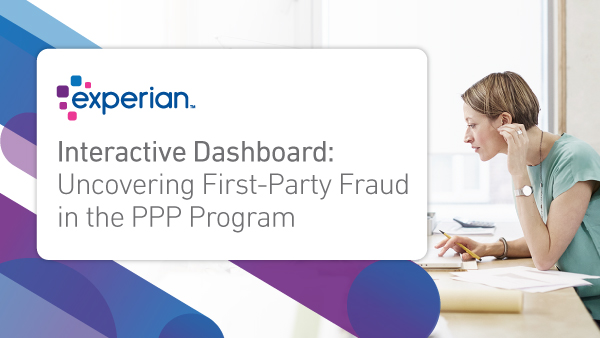
Experian dashboard of PPP program helps lenders mitigate future first-party fraud risk
The last round of stimulus for the Paycheck Protection Program (PPP) ran out of funds this week. The $953 billion stimulus program, designed to help businesses, self-employed workers, sole proprietors, nonprofit organizations, and tribal businesses continue paying their workers during the COVID-19 pandemic. As a result of emergency conditions and immediate concern to serve businesses in need, lenders relaxed vetting restrictions on PPP loan applicants. Also, they rushed to digitalize services to accommodate the massive influx of new PPP loan applications.
Relaxed restrictions, high demand, and time sensitivity surrounding PPP loans created potential entry points for first-party fraud, or fraud committed by known customers (individuals and entities).
Lenders looking to cross-sell or up-selling PPP client’s new loan products should first understand the amount of first-party fraud exposure in their PPP portfolio. Understanding potential fraud levels will help avoid unnecessary reputational risk related to the new population of PPP-related commercial clients.
Experian’s Commercial Data Sciences team wanted to give lenders the ability to understand the amount of first-party fraud in their PPP portfolio. To start the conversation on the scope of fraud in the PPP program, Experian evaluated the publicly available SBA PPP loan data for the first round of PPP loans; these were public-only loans originated without a private guarantor. We anonymized and scored this dataset with Experian’s newly developed Commercial First-party Fraud Score. The score measures the risk probability with a machine-learned algorithm to predict first-payment or early-stage defaults within seven months from account opening.
Revealing elevated levels of fraud
Scoring this public data revealed segments in some PPP lender portfolios with an elevated risk of first-party fraud, in some cases 10x to 20x riskier than the baseline. First-party fraud is a type of fraud where customers intentionally default on payments, either first-time payment or a payment sometime down the line.
By examining the distribution of a lender’s accounts as they fall within the score bands for first-party fraud risk, lenders can understand a projected dollar amount of balances to be charged off. They can also grasp the estimated dollar amount of losses per account or loss-prevention potential for the account if it had been reviewed (assuming reviewers catch 100% of fraud.)
When dealing with first-party fraud, a lender’s existing identity fraud prevention tools are typically unable to detect potential fraud. If underwriting relies on a point-in-time assessment, the lender would be blind to applicants’ behaviors that may change after loan origination and fraud insights gained from evaluating accounts from other lenders.
As a result, first-party fraud would be hidden in charge-offs, preventing lenders from identifying it for future analysis before marketing to their PPP loan population. Experian’s Commercial First-Party Fraud Score helps lenders understand the first-party fraud risk of their PPP portfolio to limit future exposure for their new PPP population.
Data visualization
View the PPP dataset displayed in our tableau data visualization. Suppose you are a lender and concerned about fraudulent PPP loans in your portfolio. In that case, Experian can provide you with a Lender ID so you can assess risk levels revealed by the Experian Commercial First-party Fraud Score.
